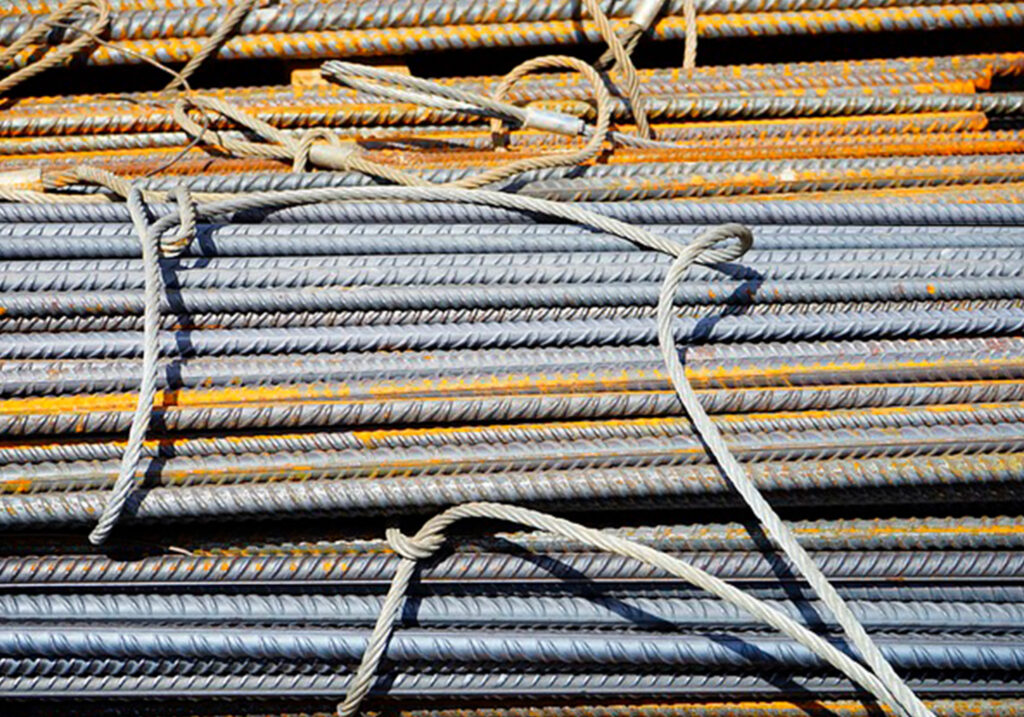Many of our readers confuse iron and steel. They feel like they are one and the same. Iron and steel are oftentimes used interchangeably since they both look similar.
However, they are two different entities with their own distinct characteristics and qualities. They also have different applications that set them apart.
Iron and steel are two fundamental materials that have shaped human civilization for centuries. Both metals are widely used in construction, manufacturing, and various industries due to their strength and versatility.
Understanding the difference between steel and iron is crucial for selecting the appropriate material for specific projects and industries.
Composition and Structure
Iron is a naturally occurring element found abundantly in the Earth’s crust. It is typically extracted from iron ore through a process known as smelting, which involves heating the ore to high temperatures in a furnace. This process results in a relatively pure form of iron, which can be classified as either wrought iron or pig iron, depending on its carbon content. Wrought iron, with its low carbon content, is known for being malleable and tough, making it suitable for various applications. On the other hand, pig iron has a higher carbon content, which makes it brittle and hard, limiting its direct use but making it an essential intermediate in steel production.
Steel, in contrast to pure iron, is an alloy primarily composed of iron and carbon, with the carbon content typically ranging from 0.2% to 2.1%. The addition of carbon and other alloying elements such as manganese, chromium, and nickel significantly enhances the mechanical properties of steel. These enhancements include increased strength, ductility, and resistance to corrosion, making steel a versatile material used in a wide range of industries. The precise composition of steel can be adjusted to meet specific requirements, allowing for the creation of specialized steel grades for different applications.
The internal structure of iron and steel also differs significantly. Pure iron has a relatively soft crystalline structure, which makes it easy to shape but also prone to deformation under stress. In contrast, the microstructure of steel is more complex due to the presence of carbon and other alloying elements. These elements form various crystalline arrangements that improve the mechanical properties of steel, such as its strength and durability. This enhanced structure allows steel to be engineered for specific applications, ranging from construction beams and automotive parts to surgical instruments and household appliances. The versatility and adaptability of steel make it an indispensable material in modern society.
Mechanical Properties
The mechanical properties of iron and steel are crucial in determining their applications. Pure iron is relatively soft and ductile, meaning it can be easily shaped but lacks the strength required for heavy-duty applications. Wrought iron, with its low carbon content, is tougher but still not as strong as steel. It is often used for decorative ironwork and historical restorations due to its malleability and resistance to corrosion. Cast iron, derived from pig iron, is hard and brittle, making it suitable for applications requiring wear resistance, such as pipes, automotive components, and cookware, but not for structural support where flexibility and tensile strength are needed.
Steel, on the other hand, offers a superior balance of strength, ductility, and hardness. By adjusting the carbon content and adding alloying elements, steel can be tailored to meet specific performance requirements. High-carbon steels are exceptionally hard and strong but less ductile, making them ideal for cutting tools, blades, and wear-resistant applications. Medium-carbon steels provide a balance of strength and ductility, suitable for automotive parts and machinery. Low-carbon steels are more ductile and easier to weld, making them ideal for construction, automotive components, and general manufacturing. The ability to fine-tune the properties of steel through alloying and heat treatment processes makes it an incredibly versatile material.
The versatility of steel’s mechanical properties makes it a preferred material in numerous industries. In construction, steel is used for beams, columns, and reinforcements due to its high strength-to-weight ratio and durability. In the automotive industry, steel’s combination of strength and ductility is essential for manufacturing safe and reliable vehicles.
Corrosion Resistance
Corrosion resistance is another significant difference between iron and steel. Pure iron and most forms of iron are prone to rust when exposed to moisture and oxygen. This susceptibility to corrosion limits iron’s use in outdoor or moist environments, as it can quickly degrade and lose its structural integrity. Wrought iron, which contains fibrous slag inclusions, offers slightly better resistance to corrosion compared to pure iron. However, it still requires regular maintenance, such as painting or coating, to prevent rust and prolong its lifespan. Despite these measures, wrought iron is not ideal for environments with high moisture or exposure to the elements.
Steel, particularly stainless steel, exhibits much greater resistance to corrosion. Stainless steel contains chromium, which forms a passive oxide layer on the surface, effectively protecting it from rust and corrosion. This makes stainless steel an excellent choice for applications in harsh environments, such as marine, medical, and food processing industries, where durability and hygiene are paramount. Additionally, stainless steel’s resistance to staining and ease of cleaning make it a preferred material for kitchen appliances and surgical instruments. The presence of chromium and other alloying elements in stainless steel ensures long-lasting performance even in challenging conditions.
Galvanized steel, which is coated with a layer of zinc, also offers enhanced corrosion resistance. The zinc coating acts as a sacrificial layer, protecting the underlying steel from rust and corrosion. This makes galvanized steel suitable for outdoor structures, pipelines, and other applications where exposure to the elements is unavoidable. The combination of strength, durability, and corrosion resistance makes galvanized steel a popular choice for construction, agriculture, and infrastructure projects.
Workability and Fabrication
Iron and steel differ significantly in their workability and ease of fabrication. Pure iron and wrought iron are highly malleable, allowing them to be easily forged, hammered, and welded into various shapes. This workability made wrought iron a popular material for decorative gates, railings, and historical architecture, where intricate designs and artistic elements were valued. However, the relatively lower strength of wrought iron limits its use in modern structural applications, where higher strength materials are required to meet safety and performance standards.
Steel’s versatility in fabrication is one of its greatest advantages. It can be rolled, forged, welded, and machined into a wide range of products, making it suitable for numerous industrial applications. Advanced manufacturing techniques, such as casting, extrusion, and 3D printing, further expand steel’s design possibilities, enabling the creation of complex and precise components. High-strength steel alloys allow for the development of lightweight yet robust structures, which are essential for aerospace, automotive, and high-rise construction projects. The ability to tailor steel’s properties through various fabrication methods ensures that it meets the specific needs of different industries.
The adaptability of steel in fabrication processes also contributes to its widespread use. In the construction industry, steel beams and columns provide the necessary support for buildings and bridges, while in the automotive sector, steel is used to manufacture durable and safe vehicle frames. The aerospace industry relies on high-strength steel for critical components that must withstand extreme conditions. Also, the use of steel in 3D printing opens up new possibilities for custom and on-demand manufacturing, allowing for rapid prototyping and production of specialized parts. The combination of workability, strength, and versatility makes steel an indispensable material in modern engineering and manufacturing.
Applications and Uses
The differences in properties between iron and steel result in distinct applications for each material. Historically, wrought iron was used for tools, weapons, and decorative items due to its toughness and malleability. Cast iron, with its hardness and wear resistance, is commonly used for engine blocks, cookware, and pipes.
Steel’s adaptability has led to its dominance in modern industries. Structural steel is a cornerstone of the construction industry, providing the framework for buildings, bridges, and infrastructure. High-strength steel is crucial for automotive manufacturing, allowing for lighter, safer, and more fuel-efficient vehicles. Stainless steel’s corrosion resistance makes it ideal for medical devices, kitchen appliances, and marine equipment. Specialty steels, such as tool steel and spring steel, are engineered for specific industrial applications, further demonstrating steel’s versatility.
Cost and Sustainability
Cost is another factor that differentiates iron and steel. Historically, iron was cheaper to produce due to simpler extraction and processing methods. However, advancements in steel production, such as the Bessemer process and modern electric arc furnaces, have made steel more affordable and widely available. Today, the cost difference between iron and steel largely depends on the specific type and grade of material.
From a sustainability perspective, both iron and steel are recyclable, but steel has a more established recycling infrastructure. Recycled steel maintains its properties and can be reused in various applications, reducing the need for raw material extraction and lowering environmental impact. Sustainable steel production practices continue to evolve, focusing on reducing carbon emissions and energy consumption.
Conclusion
While iron and steel share a common foundation, their differences in composition, mechanical properties, corrosion resistance, workability, and applications set them apart.
Iron remains important in certain industries. However, steel is the material of choice for modern engineering and construction projects due to its enhanced strength, versatility, and adaptability. Understanding these differences allows industries and consumers to make informed decisions when selecting materials for their specific needs.

